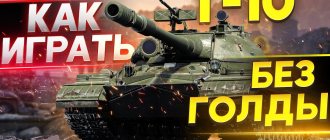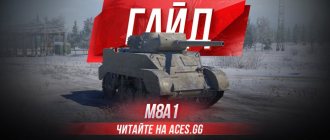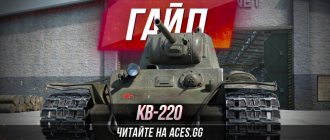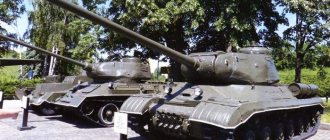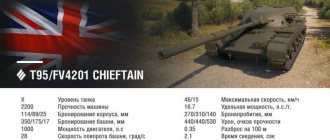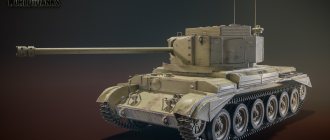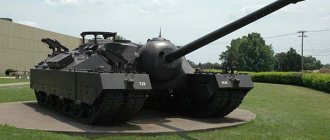Good day, dear tankers, and we want to tell you some good news. The T-50-2, a Soviet light tank that was removed from the game by the developers, entered the supertest. Perhaps the decision was right: this mobile machine really spread fear and terror on the random fields, using incredible speed and a more than decent viewing radius with maximum efficiency. However, the owners of this formidable firefly were very upset when, instead of a real imba, they were offered an MT-25.
Note that the developers unanimously stated that the T-50-2 would no longer appear in the game, but now they have submitted the car for a super test. True, now the car will be premium, but will not be put up for free sale. We dare to assume that the tank will be presented as the main prize at the end of some game event or, less likely, will become a gift for a significant date. Let's see what the legendary T-50-2 will become after its return.
Most likely, this tank will be given to old players, read the article below.
A well-deserved reward or what will be given to players for 10 years World of Tanks
T-50-2: performance characteristics
Let's start our T-50-2 guide with the fact that the tank will noticeably change. It is quite possible that many old people who drove this car will be disappointed. To begin with, we note that the T-50-2 will shift to the 6th level; let us remind you that we are talking about a premium tank, which should not only drag out battles and bring pleasure from the game, but also bring its owner a decent income.
T-50-2 TTX
So, the structural weight of the equipment is 16 tons with a load capacity of 18,000 kilograms. The tank is powered by a 480-horsepower diesel engine. If you calculate the ratio of weight to power, you get 30 horses per ton of weight, which is a pretty good indicator. However, the car only accelerates to 65 km/h. Let us clarify that until the moment of its expulsion from the pumped development branch, the firefly squeezed out 72 km/h, which made it the fastest light tank in the game. The vehicle's viewing radius is set at 370 meters, which is the worst indicator for its level.
Let's add that the T-50-2 WoT's HP is 580 units, which is slightly below average when comparing the tank with its classmates. It is noteworthy that the technology has a rather interesting level of camouflage. In particular, the stealth coefficient is 26.6%, which is relevant for a stationary and moving vehicle. Given this feature, the Soviet firefly will be able to quite comfortably occupy advantageous positions and illuminate from the bushes, while remaining invisible to the enemy.
Let's move on to weapons. Light tanks do not necessarily have to have huge armor penetration and deal tons of damage. Premium vehicles of this class earn credits for exposure and damage inflicted on it by teammates. Therefore, the developers did not equip the vehicle with a powerful weapon, however, even taking this feature into account, the T-50-2 seems to be a rather formidable opponent.
Full performance characteristics for the T-50-2
The tank is equipped with a 57 mm ZiS-4T gun, capable of penetrating 118 mm of armor. The one-time damage is small, and with a successful hit, the vehicle will reduce the HP of enemy vehicles by 85 units. Despite the rather dismal indicators, the average DPM value will be about 1,700 units, which already looks quite decent. The secret lies in the excellent rate of fire of the gun: the barrel reloads in 2.8 seconds, with an aiming speed of 1.9 seconds. The declination angles are expectedly uncomfortable - only 7 degrees, but this disease is relevant for all Soviet technology. Firing accuracy leaves much to be desired: with a dispersion of 0.40 per hundred, you can definitely forget about remote firefights, however, the stabilization of the gun is unexpectedly good, so the tank can fire quite effectively on the move.
Searchlight tank "E" / T52 (USA)
Since the late thirties, the British military industry has been creating the so-called. searchlight tanks. In 1942, the United States began work in this direction. Over time, American engineers began developing special equipment based on the serial M4 Sherman medium tank. The first such attempt yielded good results, but did not lead to the beginning of rearmament of the army. The development of original ideas continued. This searchlight tank project was named "E" and, much later, T52.
The first American project of the T10 Shop Tractor searchlight tank was based on British ideas previously implemented in the Canal Defense Light series vehicles. The M3 Lee medium tank was taken as the basis for this vehicle. It was proposed to remove the standard turret from it, in place of which a new armored unit with a searchlight installation should be mounted. Such armored vehicles could solve the assigned tasks with acceptable efficiency, but were not without drawbacks. First of all, a problem arose with the prospects of technology. The Lee tank was outdated and did not fully suit the military even as a base for special armored vehicles.
In the first half of 1944, the American military and engineers developed a project for a searchlight tank, which received the symbol “E” (also known as M4 Leaflet and T10E1). The basis of this model was the M4 Sherman medium tank. Instead of the original turret, it was planned to install a new armored cap with improved internal equipment. In the available space it was possible to fit an operator’s workplace, a machine gun mount and two high-power searchlights. Otherwise, the searchlight machine corresponded to the design of the base sample.
Experimental tank "E" at the storage site of the Aberdeen Proving Ground. The tower of the original design is turned back. Photo taken after World War II
In May and June 1944, the prototype M4 Leaflet/"E" entered testing. At the test site, it was found that the new armored vehicle with two searchlights has noticeable advantages over existing T10 tanks. The new chassis showed higher mobility characteristics, and the existing hull better protected the crew. In addition, certain advantages were provided by the presence of two spotlights at once, which had the ability to operate simultaneously.
However, such a tank was not recommended for adoption. Tank "E" was armed with only two rifle-caliber machine guns, while the previous T10, in addition to machine guns, retained a 75 mm cannon in the hull sponson. The adoption of such an armored vehicle was considered inappropriate. The army was interested in receiving a searchlight tank on the Sherman chassis, but at the same time did not want to accept a vehicle with insufficiently powerful weapons.
Already in May 1944, simultaneously with the start of testing of the first M4 Leaflet, development of the second version of the searchlight tank based on the Sherman began. By this time, the customer’s possible claims to the existing project had already become clear, which is why the main task of the new work was to create a tank equipped with both a searchlight and a weapon of sufficient power. The development of the turret and fighting compartment with the required capabilities had to be highly complex, but the successful solution of the assigned tasks gave the tank the necessary combat capabilities, and also opened its way into the troops.
As follows from the available data, the new project was considered as a direct development of the previous one, even if it involved a radical change in the main devices and target equipment. As a result, the development retained its existing name – “E”.
Once again, the searchlight tank should have been developed by slightly altering the existing vehicle, however, implying the removal of some units and the installation of others. The basis of the promising armored vehicle was to be the chassis of the serial M4 Sherman tank of one modification or another. It should be taken into account that different versions of such a tank had certain differences that could lead to the need for modifications and changes in individual elements of the promising project. The standard turret had to be removed from the hull of the medium tank, and instead it was necessary to install a new unit of a similar purpose, having both weapons and lighting equipment.
During the construction of a new prototype under Project “E”, a serial tank model M4A1 was used. Such a vehicle had a cast armored hull with a frontal part 51 mm thick and a layout traditional for American tanks. In the front part of the body, behind a large cast cover of a recognizable shape, there was a transmission, next to which a two-seat control compartment was located. The central compartment of the hull was used for the fighting compartment, and the stern housed the engine.
M4A1 tanks were equipped with a Continental R975 C1 radial gasoline engine producing 350 hp. Through a driveshaft running along the body, the engine was connected to a front-mounted mechanical transmission. The chassis had six road wheels on each side. The rollers were installed in pairs on spring-cushioned trolleys. It should be noted that such a design of the vehicle, power plant and chassis was typical only for a specific modification. When using the Sherman chassis of other versions, the appearance of the searchlight tank "E" could be different.
Previous projects proposed the removal of the original turret with cannon and machine gun armament and the dismantling of various equipment for the fighting compartment, primarily the gun ammunition stowage. The new version of the “E” project did not allow us to abandon the racks, but their placement and volumes were noticeably changed. Due to this, it was possible to free up space for installing an electric generator necessary for the operation of the spotlight. Through individual transmission elements, the generator was interfaced with the main engine.
Specific requirements for the vehicle did not allow the use of existing types of turrets. The existing turret of the M4 tank did not have free volumes to accommodate a searchlight, and it was impossible to fit a gun into the volumes of the M4 Leaflet turret. As a result, it was necessary to develop a completely new fighting compartment. All required systems had to be located inside a completely new tower of the required shape.
As part of the “E” project, a special tower was created; it was proposed to produce it using the casting method. The tower was based on a low round support, placed on the shoulder strap of the hull and smoothly transitioning into other elements. The tower was equipped with a slightly inwardly inclined forehead and sides. On its frontal part, it was planned to install mounts for a gun mount, noticeably placed forward. The gun and its mountings were additionally covered with a rectangular armor mantlet with a protruding central element. To properly use the internal volumes, the gun mount was shifted from the center to the left side. To the right of the mask there was a rectangular protrusion, in the front wall of which there was a slit window as a searchlight embrasure. It was proposed to use a relatively large feeding niche, noticeably protruding beyond the projection of the shoulder strap.
The internal volume of the new tower was divided into compartments of different sizes using a vertical partition. The larger left compartment served as a fighting compartment and was connected to the internal volumes of the hull. The isolated right compartment of the tower was smaller in size and accommodated a searchlight installation. Due to the reduced size of the fighting compartment, it was possible to get by with only one hatch in the roof. It was located on the left side of the tower, on the commander's cupola with a set of viewing instruments.
The presence of a spotlight compartment led to a reduction in available volumes, and in addition, imposed certain weight restrictions. Based on the results of an analysis of the available capabilities, it was decided to use a lightweight M6 rifled tank gun of 75 mm caliber. This gun differed from similar systems in that the barrel length was reduced to 39 calibers and the thickness of its walls was reduced, which led to a slight reduction in weight. The main carrier of the M6 gun was the M24 Chaffee light tank.
To make more efficient use of the internal volumes of the turret, the existing lightweight gun was equipped with recoil devices of a concentric design. The recoil brakes and knurler were located around the barrel in close proximity to it. The swinging artillery unit had mechanical and manual drives for vertical guidance. In addition, it was equipped with a stabilizer. The latter was also associated with a swinging spotlight. Despite the use of part of the internal volumes of the tank to accommodate new devices, it was possible to place 83 unitary projectiles for the gun in the fighting compartment.
Existing restrictions did not allow the searchlight tank “E” to be equipped with a coaxial machine gun. However, the hull retained a frontal ball mount with one M1919 rifle-caliber machine gun. Embrasures were not used for firing personal weapons.
In the right compartment of the tower, separated by partitions, there was a carbon arc lamp with a system of mirrors. As in previous projects, the light flux was supposed to enter the front concave mirror, be reflected on the aft rectangular one, and then be output through the frontal embrasure of the tower. It was again proposed to use movable curtains and light filters designed to prevent the enemy from observing. The searchlight installation could swing in a vertical plane.
A curious feature of the updated project of the searchlight tank “E” was the preservation of the crew characteristic of the Shermans in the basic configuration. The car was to be driven by a crew of five people. The driver and gunner were located in front of the hull, on the left and right, respectively. There were hatches above their places; the frontal plate of the hull had openings for viewing devices. Three other tankers were located in the fighting compartment. The gunner was placed in front of the turret on the left side. Immediately behind him was the commander, above whose place there was a turret with a single hatch. The appearance of the searchlight compartment led to a relocation of the loader's position. Now he was located directly behind the breech of the gun.
From the point of view of dimensions, weight and mobility, the new model of armored vehicles, in general, corresponded to the tanks of the base model. At the same time, there had to be some differences of one kind or another. In addition, a characteristic difference was the ability to illuminate the enemy. Thanks to the searchlight, the new “E” tank could operate independently in the dark or support the operation of other armored vehicles.
In the last months of 1944, construction began on the first experimental “E” of the new model. A serial medium tank of the M4A1 modification, equipped with a 76-mm rifled gun, was sent for conversion. During the rebuilding according to the new project, the tank lost its turret and some of its internal components, after which a generator and other systems were installed in the hull. Large sections of the front and rear were cut off from the standard turret, and new cast units of the required shapes and sizes were welded in their place. Also, the necessary partitions, etc., appeared inside the dome. devices.
The conversion of the production tank into a prototype was completed at the very beginning of 1945, and soon the “E” vehicle was put out for testing. The checks were carried out at the Fort Knox base. Over the next few months, specialists from organizations involved in the development and representatives of the army carefully studied the resulting vehicle in different conditions in order to solve various problems. It took several months to fully test the experimental searchlight tank. The final test report was not released until June of that year.
Diagram of a turret with cannon and machine gun armament and a searchlight
Testers noted that the updated version of the “E” armored vehicle, equipped with a searchlight installation and a 75-mm gun, has significant advantages over all previously created models of the CDL family of American and British development. The modern chassis of the M4 Sherman medium tank gave higher mobility, reinforced armor protected against many threats, and maximum unification made operation easier. At the same time, the tank could illuminate the target with a powerful searchlight and, if necessary, independently destroy it with a shot from the M6 gun. Based on the totality of technical, operational and combat characteristics, the “E” tank was recognized as the best vehicle in its class.
After successfully passing the tests, the promising searchlight tank could be put into service and go into mass production. However, the checks were completed only at the very beginning of the summer of 1945. The fighting in Europe had ended by this time, and the war in the Pacific was already coming to an end. In this regard, the command began to cut costs on the creation of new types of weapons and equipment, as a result of which a number of projects were closed, and some already approved programs were cancelled.
Along with other projects, a new type of searchlight tank was also cut. The launch of mass production of such equipment was considered inappropriate. The only prototype built was sent to Aberdeen Proving Ground for long-term storage. The experimental vehicle was supposed to sit in storage for several years, after which it would be sent for disposal due to the lack of real prospects. Probably, when deciding to send the tank for storage, the military did not think that they would have to return to this interesting project in the future.
Serial production of the E tanks was not started. In addition, the American army had no experience using searchlight vehicles in real conflicts. These factors may have been the reason why no work was carried out on the topic of specialized searchlight tanks over the next few years. The situation changed only after the start of a new armed conflict.
In 1950, the American military department again became interested in the subject of tanks with their own searchlight installations. Based on the desire to gain an advantage over the enemy, the army showed interest in various types of weapons and equipment. Among other things, the military remembered the previously closed Project “E”. The successes of this project led to its resumption.
In the same year, work began on the project with the symbol T52. His goal was to create an updated version of the previously developed "E" searchlight tank. It was planned to update the car, first of all, using a newer chassis. The new version of the tank was to be based on the Sherman M4A3 chassis.
From the first prototype, built on the basis of the M1A1 tank, the new T52 was supposed to differ in the use of a welded hull with similar protection parameters, a 500-horsepower Ford GAA gasoline engine, a chassis using horizontal springs, etc. Some elements of the fighting compartment could also be updated. In particular, electrical systems could be redesigned using modern products.
According to some reports, the T52 searchlight tank project has passed the development stage and reached the construction of a prototype. When assembling the new prototype, a ready-made turret could be used, manufactured in the mid-forties and intended for the experimental “E”. It can be assumed that the resulting experimental tank retained all the positive features of the previous vehicle with a similar fighting compartment and lighting equipment. As a result, it had a certain chance of entering service.
However, this time too the searchlight tank could not reach mass production. For all its advantages, the new T52 machine had certain economic disadvantages. A specific feature of the proposed tank was the presence of one powerful searchlight located under armor protection. The turret with a cannon and searchlight was distinguished by its high cost, which worried the potential customer. As an alternative to lighting equipment in a special turret, an 18-inch (457 mm) searchlight could be considered, openly mounted on the serial turrets of M4 tanks. Similar equipment has already been produced by industry and mastered by the troops, significantly increasing their potential in difficult conditions.
As simple calculations showed, the cost of one T52 tank was equal to the price of purchasing and installing 18-inch searchlights on all combat vehicles of four tank battalions. Cheaper mounted equipment was inferior to the tower installation in terms of illumination power and range, and also did not have any protection and, as a result, was not highly survivable. However, even with such shortcomings, the additional external searchlight looked much more interesting and profitable than a special tower with an internal searchlight installation.
Based on the results of this comparison, the American military department decided to do without new specialized combat vehicles. Equipping existing and new equipment with its own external spotlights seemed more profitable in terms of savings. The separate T52 searchlight tank, in turn, was considered overly complex, unreasonably expensive and therefore unnecessary. After successful tests, which opened up a great future for him, the most interesting project was closed.
Work on the T52 project was stopped already in 1950. Along with the closure of the project, a fundamental decision was made concerning the further development of armored combat vehicles. To ensure the possibility of combat work in the dark, all tanks and other armored vehicles had to be equipped with their own searchlights. In addition, by this time it was possible to obtain certain results in the field of night vision devices. Such equipment should also have been used when creating new equipment. There was no longer any need to develop special searchlight tanks. The T52 was the last of its class to be built in the USA.
Based on materials from: https://aviarmor.net/ https://network54.com/ https://panzerserra.blogspot.fr/ Hunnicutt RT Sherman. A History of the American Medium Tank, Navato, CA. Presidio Press, 1971
T-50-2 armor
Despite the fact that armor is not the main thing for light vehicles, the T-50-2 is a premium tank that is quite well protected. Of course, the stated booking parameters are guaranteed not to impress the heavyweights, PT or ST, but in general, they look quite decent.
Let's start the inspection from the strongest place of any tank, which is traditionally the turret. In the frontal projection we are offered a confident 52 millimeters of armor and a ricochet-shaped turret, partially covered by a gun mantlet. The VLD is covered with 37 mm armor plates located at a rational angle. The lower frontal part of the tank is much less protected, so it is better not to expose this element, as well as the sides and rear, to enemies.
In general, the armor characteristics of the T-50-2 are quite consistent with the concept of tier 6 light tanks, but the problem is that the vehicle will not be a beneficiary. This means that the firefly will often encounter “eights”, which are guaranteed to pierce the tank in any plane, without even bothering to aim.
How to play T-50-2
When choosing tactics for playing the T-50-2, you need to take into account that you are going into battle in a maneuverable, fairly fast and fast-firing vehicle that has no armor. Focusing on these features, you can think through your behavior in battle. In general terms, there are only 2 possible scenarios here: passive or active light.
Considering its camouflage characteristics, the T-50-2 is an excellent ambush tank. It is noteworthy that the car does not glow much when in motion, which is guaranteed to allow it to take a promising position in dense bushes in a potentially dangerous direction. This concludes the technical maneuvers for the next 2-3 minutes, so you can go to the kitchen for a cup of tea and a sandwich.
While drinking tea, don’t forget to periodically move the mouse so that the tank rotates its turret, highlighting unwary opponents. The main thing here is not to shoot even at tempting targets and not to move your body. In addition, it is important to clearly grasp the moment when the sad situation will end and act according to the circumstances. If the enemy breaks through the flank, we quickly hide in an unknown direction; if ours, we rush to the undead enemies, rush to look for artillery and try in every possible way to deal damage in order to earn more silver.
Active light is a lot of drive and is more likely to go to the hangar in the first minutes of the battle. We do not forget that even a single-level vehicle will take out a T-50-2 with a maximum of two shots, so under no circumstances do we engage in direct firefights with the enemy, and never stand still. Ideally, you need to wind circles in the center of the map, changing the amplitude and trajectory of movement. Having lost more than half of our strength, we pull back to the rear or take a position for passive exposure.
T-50-2 in the USSR research tree
Brief summary of the T-50-2
Let's summarize the information above, analyzing the characteristics of the machine into strengths and weaknesses.
Pros:
- Rate of fire;
- Disguise;
- Speed and maneuverability;
- Reservation and shape of the tower;
- Stabilization of the gun.
Minuses:
- Firing accuracy;
- View radius;
- Hull armor;
- Margin of safety;
- Armor penetration and one-time damage.
If we look at the tank as a whole, it looks quite decent, and if it is offered as a prize, you definitely need to try hard to complete the objectives of the game event. We would like to add that the characteristics given in the review are not final. The vehicle is being tested, so by the time of release, the tank's combat capabilities may change for the better or for the worse.
Modifications
T-62
- (1961) - Basic model, based on the T-55.
T-62A
- (1961) - Modification of the T-62 tank. A new cast turret with a rifled 100 mm D-54TS cannon was installed. To remove spent cartridges, the vehicle is equipped with a mechanism for ejecting them through the rear hatch of the turret. The tank was not mass-produced. This modification of the tank was produced in 1961 in a small batch.
T-62K
- (1964) Commander T-62 with radio station R-130. Additionally, navigation equipment TNA-2, a HF radio station and an AB-1 charging unit were installed to power consumers during long-term work on site. At the same time, the ammunition load of the cannon and machine gun was reduced, and the placement of spare parts was changed.
T-62D
- A modification of the T-62 tank equipped with an active protection complex. The Drozd active protection complex. Adopted into service in 1983.
T-62D-1 (1983) - a variant of the T-62D tank with a V-46-5M engine.
T-62M
- (1983) - A tank that underwent deep modernization in 1983-1985. The tank was equipped with: additional armor protection for the turret, hull and bottom; rubber-fabric side anti-cumulative screens; antineutron lining on the tower; laser rangefinder KTD-2; ballistic computer BV-62. The gun has a heat-protective casing. A caterpillar from the T-72 tank was introduced.
T-62M-1
- T-62M variant with a V-46-5M engine, a BV-62 ballistic computer and a KTD-2 laser rangefinder.
T-62M1
- T-62M without KUV.
T-62M1-1
- T-62M-1 without KUV.
T-62M1-2
- T-62M without KUV and without additional hull armor.
T-62M1-2-1
- T-62M1-2 with V-46-5M engine.
T-62MK
- Komandirsky T-62M, radio station R-130 and TNA-3
T-62MV
- (1985) - The tank is equipped with mounted dynamic protection, a heat-protective casing on the gun, the bottom is additionally armored, side rubber screens 10 mm thick are installed, and the “Volna” fire control system is installed.
T-62MV-1
- - a version of the T-62MV tank with a V-46-5M diesel engine.
T-62MD
- T-62M equipped with an active protection complex “Drozd” active protection complex.
T-62AM
- Modification of the T-62 tank with a 125mm cannon.

